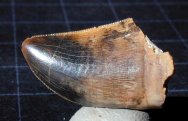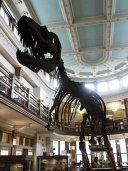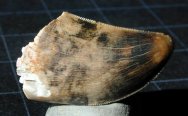 Description:
Presented is an excellent quality Albertoaurus dinosaur tooth
found
in Northern Montana in the Judith River Formation. This is a historically
important area. Early paleontologists like Edward Drinker Cope
explored
here as early as 1876. Description:
Presented is an excellent quality Albertoaurus dinosaur tooth
found
in Northern Montana in the Judith River Formation. This is a historically
important area. Early paleontologists like Edward Drinker Cope
explored
here as early as 1876.
Albertosaurus (meaning "Alberta lizard") is a genus of
tyrannosaurid theropod dinosaur that lived during the Late Cretaceous
Period, more than 70 million years ago in western North America.
Although a large theropod, Albertosaurus at 2 tonnes was much smaller
than its more famous T-Rex. Some 20 Albertasourus have been found,
providing detailed anatomical data; 22 at one site in  Alberta
shows evidence of pack behavior and ontogeny data. Alberta
shows evidence of pack behavior and ontogeny data.
All
tyrannosaurids, including Albertosaurus, shared a similar bauplan.
As is typical for a
theropod, Albertosaurus was bipedal and balanced the heavy head
and torso with a long tail. However, tyrannosaurid forelimbs were
extremely small for their body size and retained only two digits.
The hind limbs were long and ended in a four-toed foot. The first
digit, called the hallux, was short and only the other three contacted
the ground, with the third (middle) digit longer than the rest.
Albertosaurus may have been able to reach speeds of 25–30
miles per hour
The
type species, Albertosaurus sarcophagus, was first discovered
in
the province of Alberta, its namesake. Some scientists consider
Gorgosaurus libratus as a second species of Albertosaurus.
Note
the fine serration of the tooth, a tell-tell sign of the fierce
Theropod dinosaurs. The suborder first appeared in the Carnian age
of the Late Triassic period some 230 million years ago becoming
the sole large terrestrial carnivores from the Early Jurassic until
the end Cretaceous mass extinction some 65 Ma. Their remaining genetic
legacy are more than 9000 living bird species that evolved in the
Late Jurassic from the small and specialized coelurosaurian dinosaurs.
The characteristics linking theropods to birds are the three-toed
foot, a furcula (wishbone), air-filled bones and (in some cases)
feathers as well as brooding of their eggs
|



